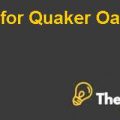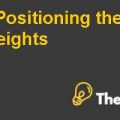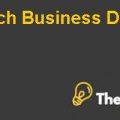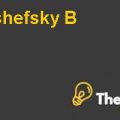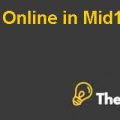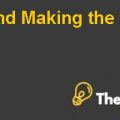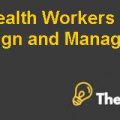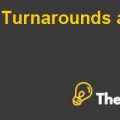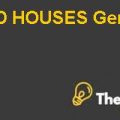
OPERATIONS MANAGEMENT ASSIGNMENT Case Solution
Question 1
The solution for the key metrics table is shown in the table below. All calculations could be seen in the excel spreadsheet.
|
|
Mean Demand per week |
Standard deviation |
Time Ratio |
Desired Service level (assumed) |
Lead Time Factor |
| Shampoo | 472 |
140.70 |
1.414 |
95% |
1.645 |
| Cotton Balls | 63 |
16.00 |
2.000 |
95% |
1.645 |
| Conditioner | 128 |
40.61 |
1.414 |
95% |
1.645 |
| Cotton Swabs | 62 |
17.92 |
2.000 |
95% |
1.645 |
| Body Wash | 245 |
75.47 |
1.414 |
95% |
1.645 |
| Lotion | 107 |
29.71 |
1.414 |
95% |
1.645 |
| Item Description |
Safety Stock |
Order Up To Target |
Business Intuition: Impact on Average Inventory |
| Shampoo |
327.28 |
799.52 | Demand is expected to go up |
| Cotton Balls |
52.63 |
115.24 | Demand is expected to go down |
| Conditioner |
94.46 |
222.07 | Demand is expected to remain same |
| Cotton Swabs |
58.95 |
120.49 | Demand is expected to go down |
| Body Wash |
175.56 |
420.25 | Demand is expected to go up |
| Lotion |
69.10 |
176.26 | Demand is expected to remain same |
Q uestion 2
The ticket agent utilization rates and the average wait in minutes would be as follows:
|
Critical |
60 per hour split across two queues for two counters |
60 per hour combined into one queue for two counters |
60 per hour split across three queues for three counters |
60 per hour combined into one queue for three counters |
|
Performance |
||||
|
Measure |
||||
| Ticket Agent Utilization |
75% |
67% |
50% |
67% |
| Average Wait in Minutes |
4.5 |
4.00 |
3.00 |
4.00 |
|
Business Intuition: Better, Worse, Same? |
Better |
Better |
Better |
|
Question 3
The best combination of the product concepts which need to be developed are as follows:
|
Product Concept |
Profitability Index |
Average Ratings |
Development Costs |
Revenues |
|
Artificial Sweetener |
$ 15.72 | $ 5.25 | $ 318,000 | $ 1.90 |
|
|
||||
|
Cane Syrup |
$ 6.51 | $ 5.75 | $ 522,000 | $ 2.30 |
|
Chili-Lime Rub |
$ 0.23 | $ 5.75 | $ 433,000 | $ 2.20 |
|
Cocao Powder |
$ 8.70 | $ 5.75 | $ 563,000 | $ 1.80 |
|
Dijon Mustard |
$ 5.15 | $ 5.50 | $ 621,000 | $ 2.40 |
|
|
||||
|
|
||||
|
Lemon Juice |
$ 2.47 | $ 3.75 | $ 365,000 | $ 2.20 |
|
Pandanus Leaves |
$ 12.56 | $ 7.00 | $ 207,000 | $ 2.20 |
|
Pickle Juice |
$ (0.49) | $ 5.00 | $ 616,000 | $ 1.20 |
|
Powdered Cinnamon |
$ 8.56 | $ 5.25 | $ 561,000 | $ 1.50 |
|
|
||||
|
Soy Sauce |
$ 5.20 | $ 5.50 | $ 731,000 | $ 2.10 |
|
Sriracha Sauce |
$ 3.21 | $ 4.25 | $ 374,000 | $ 1.50 |
|
|
||||
|
Tasmannia Pepperberry |
$ 13.48 | $ 6.50 | $ 141,000 | $ 1.50 |
|
|
||||
|
Vanilla Extract |
$ 1.17 | $ 5.75 | $ 515,000 | $ 2.20 |
|
|
||||
| $ 5,967,000 | $ 25.0 |
This portfolio combination is the most optimal of all and it remains under the $ 6 million available funds cap as well as it achieved 2017 revenue target of $ 25 million. The decision and the choices of the product concepts within this portfolio have been made on the tradeoff between two parameters. The first one is the financial aspect which has been measured through profitability index for each product concept and the second one is the average score or rating for the other factors associated with the different product concepts.
The profitability index, average ratings and the revenues of all the products within the desired portfolio are also depicted in the graph below:
Question 4
The cost driver framework has been applied to Maruti Suzuki Company as follows:
Design
The design of the automotive vehicles of the company has been affected by the standards of the industry. There has been a large number of benchmark procedures and common standards developed within this industry and this has led towards the creation of certain expectations of the customers. Therefore, in this way the design becomes the reflection of the customers and a major cost driver for Suzuki Maruti. The issues dealt here include product line complexity and material specifications..................
This is just a sample partial case solution. Please place the order on the website to order your own originally done case solution.

